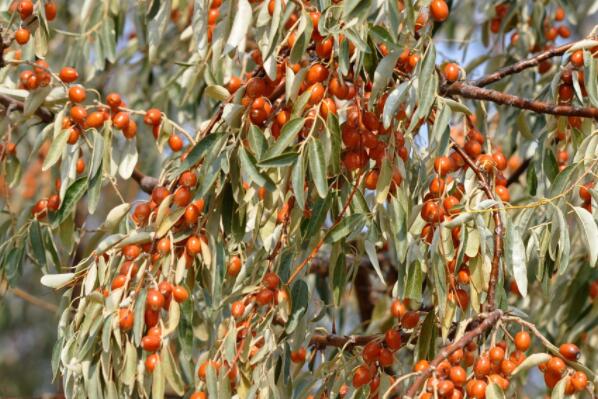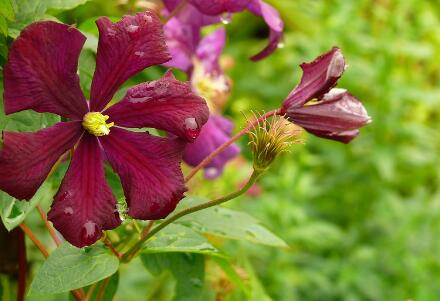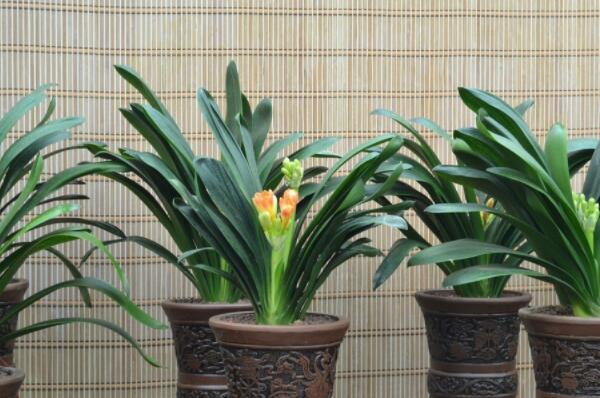What does the tree of Elaeagnus angustifolia look like? How much is the seedling price? How is the planting benefit? What's the way?
Elaeagnus angustifolia tree aliases are silver willow, fragrant willow, cinnamon willow, Qili incense. Strong vitality, with drought resistance, wind and sand, salt and alkali resistance, barren and other characteristics. So what does it look like? How much is the seedling price? How is the planting benefit? What are the methods? It is learned from Ningxia seedling base that the price of Elaeagnus angustifolia seedlings is 0.3-0.8 yuan per tree.

What does the Elaeagnus angustifolia tree look like?
Elaeagnus angustifolia is a deciduous tree or tree, 5 to 10 meters high, the trunk is unarmed, the branches are prickly, the thorns are long 3~4cm, showing reddish brown. Young branches densely covered with silver-white scales, falling off in old age, showing chestnut brown. Leaves alternate, with silvery slender stalks; leaf blade thinly papery, oblong-lanceolate, long 3~7cm, broadly 1~1.3cm, base cuneate, entire, apex obtuse or obtuse, with silvery white rounded scales when young, glabrescent later, gray-white below, densely silvery-white scales, glossy. The flowers are clustered in the leaf axils of the lower part of the branchlets, the calyx is silver-white and the petals are golden. Densely covered with silver-white scales, fragrant; calyx tube campanulate, upper end 4-lobed, lobes broadly ovate or ovate-oblong, inner surface covered with white stellate pilose; stamens 4, few filaments; upper end of style curved, conical disk surrounding base of style. Fruit oval, long 2~3cm, diam. 1~1.5cm, pink or crimson, densely covered with silver-white scales, pulp powdery, milky white or yellowish. The flowering period is from May to July and the fruiting period is from August to October. Born in mountains, plains, beaches, deserts, cultivated or wild.
What is the planting benefit of sand jujube?
Natural Elaeagnus angustifolia trees are only distributed in desert and semi-desert areas where the precipitation is less than 150 mm, which is related to the groundwater level, which is lower than 4 meters. Elaeagnus angustifolia trees have higher requirements for heat conditions. Elaeagnus angustifolia grows well when the accumulated temperature of ≥ 10 ℃ is more than 3000 ℃. When the accumulated temperature is lower than 2500 ℃, the fruit is less. The active accumulated temperature began to germinate when the accumulated temperature was more than 5 ℃, the growth entered the peak season when the activity accumulated temperature was more than 10 ℃, and the flowering stage entered when the activity accumulated temperature was more than 16 ℃. The fruit is mainly formed in the high temperature period of summer when the average temperature is above 20 ℃. The ability of saline-alkali tolerance is also strong, but it varies with different kinds of salt, and it has strong adaptability to sulfate soil and weak resistance to chloride. It can grow when the total salt content of sulfate soil is less than 1.5%, but it is not suitable for growth when the total salt content of chlorinated saline soil exceeds 0.4%. Elaeagnus angustifolia has developed lateral roots and large root breadth, which can produce many nodules in loose soil, among which nitrogen-fixing rhizobia can also improve soil fertility and improve soil. The sprouting ability of lateral branches is strong, and the growth of terminal buds is weak. The branches are dense and often form dense clusters of plants. After the branches are buried in sand, they are easy to grow adventitious roots and have the effect of preventing wind and fixing sand. In the Hexi Corridor of Gansu Province, the sap began to flow in late March, sprouted in the middle of April, flowered from the end of May to the beginning of June, the flowering period was about 3 weeks, the young fruit was seen in early July, the fruit took shape in late August, and the fruit matured in October. The fruit period is about 100 days. The phenological phase of Ningxia is similar to that of Hexi Corridor, and the phenological phase of central Inner Mongolia is slightly later.
What are the planting methods of sand jujube?
1. Sowing and raising seedlings: sowing and raising seedlings are mostly in spring. The seedlings raised in spring should be treated in December of the first winter. The method is to wash the seeds clean, mix them with the same amount of fine sand, put them into a pre-dug seed treatment pit (80 cm deep, 100 cm wide, and the length depends on the number of seeds), or pile up the ground according to 40 cm to 60 cm thick, and cover them with sand to form ridges around. Fill enough water (10 cm 20 cm above the seeds), and after the water seeps or freezes, the sand is covered with 20 cm sand over the winter. Before sowing, the seeds that have not been stored in winter can be soaked in 50-60 ℃ warm water for 2-3 days. After being removed, they are mixed with horse dung and placed in a sunny place to moisturize and germinate. After 30-40% of the seeds are cracked, they can be sown. Seeds sown in autumn do not need to be sprouted. Elaeagnus angustifolia seedlings can be raised by field strip sowing, with row spacing of 25 cm, sowing depth of 3-5 cm, about 100 seeds per meter in regular sowing ditch, about 40 jin per mu, covering soil after sowing, seedlings in the first ten days of June, seedling spacing of 7 cm, and seedling protection of 30,000 to 40,000 seedlings per mu. The seedlings of the same year are 50-60 cm high and can be planted in the nursery.
2. Cuttage seedlings: the branches of the same year are often used for tender wood cutting in late spring and early autumn, or the old branches are cut in early spring. When the tender wood cuttings were carried out, the sturdy branches of the current year were selected as cuttings when the plants were growing vigorously from the end of spring to early autumn. After cutting off the branches, select the sturdy parts and cut them into segments 5-15 cm long, each with more than 3 leaf nodes. When cutting cuttings, it should be noted that the upper cut is cut flat at about 1 cm above the uppermost leaf node, and the lower cut is about 0.5 cm below the lowest leaf node, and the upper and lower cut should be flat (knife should be sharp). When hardwood cuttings are carried out, strong branches are selected as cuttings after the temperature rises in early spring. Each cuttage usually retains 3-4 nodes, and the cutting method is the same as that of softwood cuttings. The main results are as follows: (1) temperature: the optimum temperature for cuttings rooting is 20 ℃ ~ 30 ℃, which is lower than 20 ℃, and it is difficult and slow for cuttings to root; when the temperature is higher than 30 ℃, the upper and lower cuttings are easy to be infected by bacteria and rot, and the higher the temperature is, the greater the proportion of rot is. When there is a low temperature after cutting, the heat preservation measure is mainly to wrap the flowerpot or container used for cutting with thin film; when the temperature is too high after cutting, the cooling measure is mainly to shade the cuttings, to cover 50-80% of the sun, and at the same time, spray the cuttings 3-5 times a day, with more times of spraying when the temperature is higher in sunny days, lower temperatures and higher temperatures in rainy days, but less or no spraying times.
(2) humidity: the relative humidity of the air must be kept at 750.85% after cutting. The basic requirement for cuttings to take root is to ensure that cuttings are fresh and tender and can be used to produce rooting substances before they take root. However, cuttings without rooting can not absorb enough water to maintain their water balance, so it is necessary to reduce the water evaporation of cuttings by spraying: under shaded conditions, the cuttings are sprayed 3-5 times a day. The higher the temperature in sunny days, the more the times of spraying, the lower the temperature in cloudy and rainy days, the less or no spraying. But with excessive spraying, cuttings are easy to be infected by bacteria and rot, because many kinds of bacteria exist in the water.
(3) Light: cutting propagation is inseparable from sunlight, because cuttings continue to carry out photosynthesis to produce nutrients and rooting materials to supply their rooting needs. However, the stronger the light, the higher the temperature in the cuttings, the more exuberant transpiration of cuttings, and the more water consumed, which is not conducive to the survival of cuttings. Therefore, after cutting, the sun must be shaded by 50% to 80%, and then gradually removed after the root system grows: remove the sunscreen at 4:00 every sunny day, and cover it before 9:00 the next day.
3. pressing seedlings: select strong branches and peel off the bark from about 15cm to 30cm below the top. The width of the peeled wound is about one centimeter, and the depth is limited to just peeling off the epidermis. Cut a piece of film 10 cm 20 cm long and 5 cm 8 cm wide, put some wet garden soil on it, and wrap it around like a wound. The upper and lower ends of the film are tightly tied and bulged in the middle. Take root in about four to six weeks. After taking root, cut off the root system along the edge of the branch to form a new plant.
Time: 2019-03-20 Click:
- Prev

When is the season of transplanting Liana Flower Queen Clematis? How many years can you live by planting? How many times a year do you bloom?
Liana flower queen clematis alias peony, passionflower, gold package silver, mountain Aristolochia mandshurica, passionflower, Weilingxian, more common in garden cultivation, has a certain ornamental value. Its florescence is usually from June to September and has a certain fragrance. The root of Clematis can also be used as medicine.
- Next

Changchun city flower Magnolia seed price is about how much per jin? How to sprout? How do you plant it? What are the methods?
Magnolia is also known as Magnolia, Lycoris, Magnolia, the city flower of Changchun, the flowering period is as long as 30-50 days, mainly in winter and spring, New Year's Day also blossoms around the Spring Festival. So how much is its seed price per jin? How to sprout? How do you plant it? What are the methods?
Related
- Fuxing push coffee new agricultural production and marketing class: lack of small-scale processing plants
- Jujube rice field leisure farm deep ploughing Yilan for five years to create a space for organic food and play
- Nongyu Farm-A trial of organic papaya for brave women with advanced technology
- Four points for attention in the prevention and control of diseases and insect pests of edible fungi
- How to add nutrient solution to Edible Fungi
- Is there any good way to control edible fungus mites?
- Open Inoculation Technology of Edible Fungi
- Is there any clever way to use fertilizer for edible fungus in winter?
- What agents are used to kill the pathogens of edible fungi in the mushroom shed?
- Rapid drying of Edible Fungi

